Agarwood & Musk, Agar Sandal, Aloeswood & Jasmine, Amber & Frankincense, Celestial Fruits, Chocolate & Vanilla
Flora Fluxo, Floral Bouquet, Gold Sandal, Jasmine & Lotus, Jasmine & Nag Champa, Lotus & Kewra
Marigold & Juhi, Musk & Amber, Musk & Champa, Musk Heena, Musk & Patchouli, Pink Rose
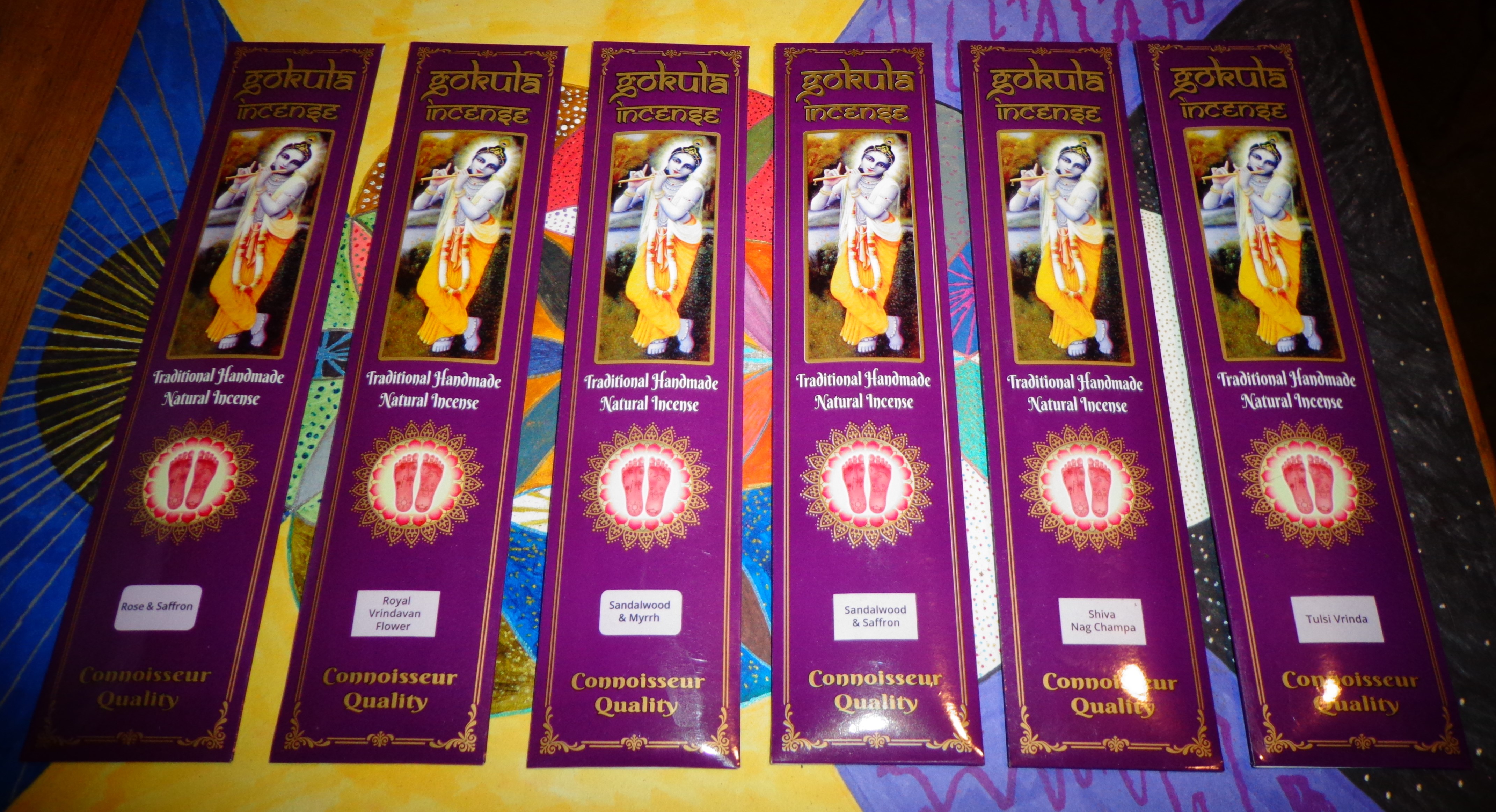 This is the last of four in a series of Gokula Incense reviews, please see the first installment for an introduction to the company.
This is the last of four in a series of Gokula Incense reviews, please see the first installment for an introduction to the company.
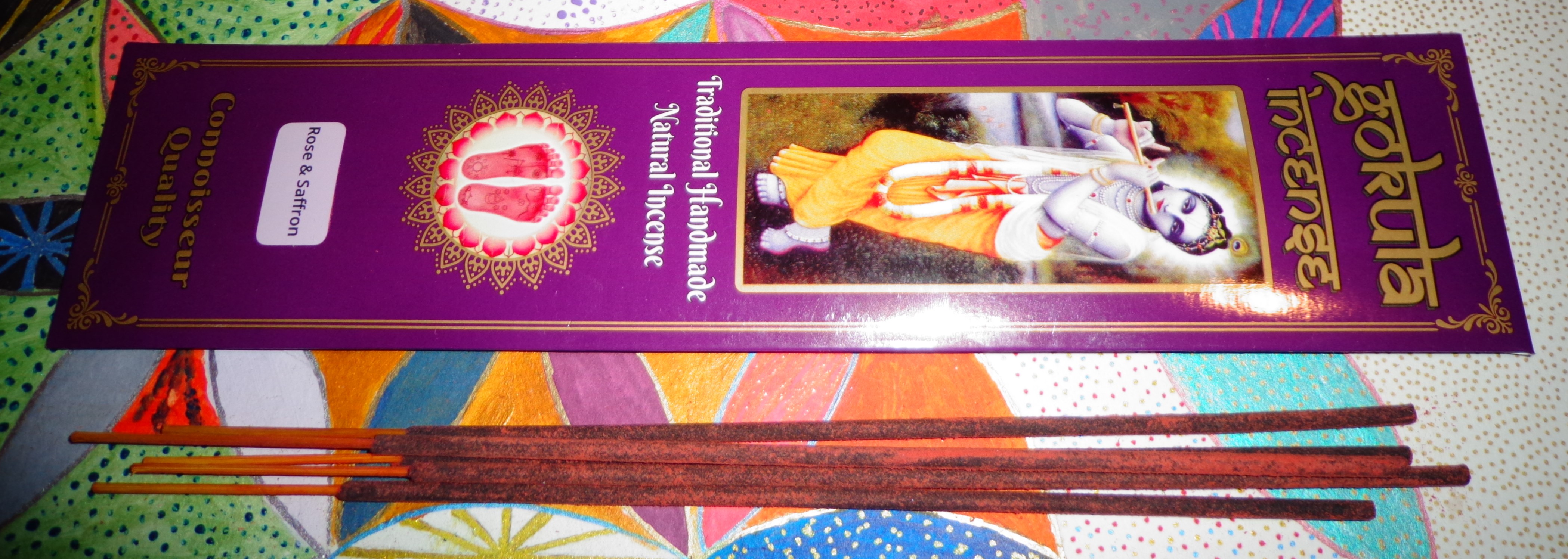 Rose & Saffron is a natural pairing for incense and this one acts as a very different incense to the Pink Rose I covered last time. For one, this isn’t as sweet, but you can still feel some similarities between the two incenses around the base. Strangely enough I detect something like a chocolate note but I also felt what is stepping in for the saffron here might be more obvious on the fresh stick than on the burn. It also has some sort of camphorous-cooling elements in the mix as well. This is very different from, say, the Vedic Vaani Saffron Rose and that’s a good thing as this combination of elements doesn’t really remind you of other incenses and keeps it fresh. In the end I kind of love the minty sort of top on it. Quite a bit to explore on this one, there’s a lot going on.
Rose & Saffron is a natural pairing for incense and this one acts as a very different incense to the Pink Rose I covered last time. For one, this isn’t as sweet, but you can still feel some similarities between the two incenses around the base. Strangely enough I detect something like a chocolate note but I also felt what is stepping in for the saffron here might be more obvious on the fresh stick than on the burn. It also has some sort of camphorous-cooling elements in the mix as well. This is very different from, say, the Vedic Vaani Saffron Rose and that’s a good thing as this combination of elements doesn’t really remind you of other incenses and keeps it fresh. In the end I kind of love the minty sort of top on it. Quite a bit to explore on this one, there’s a lot going on.
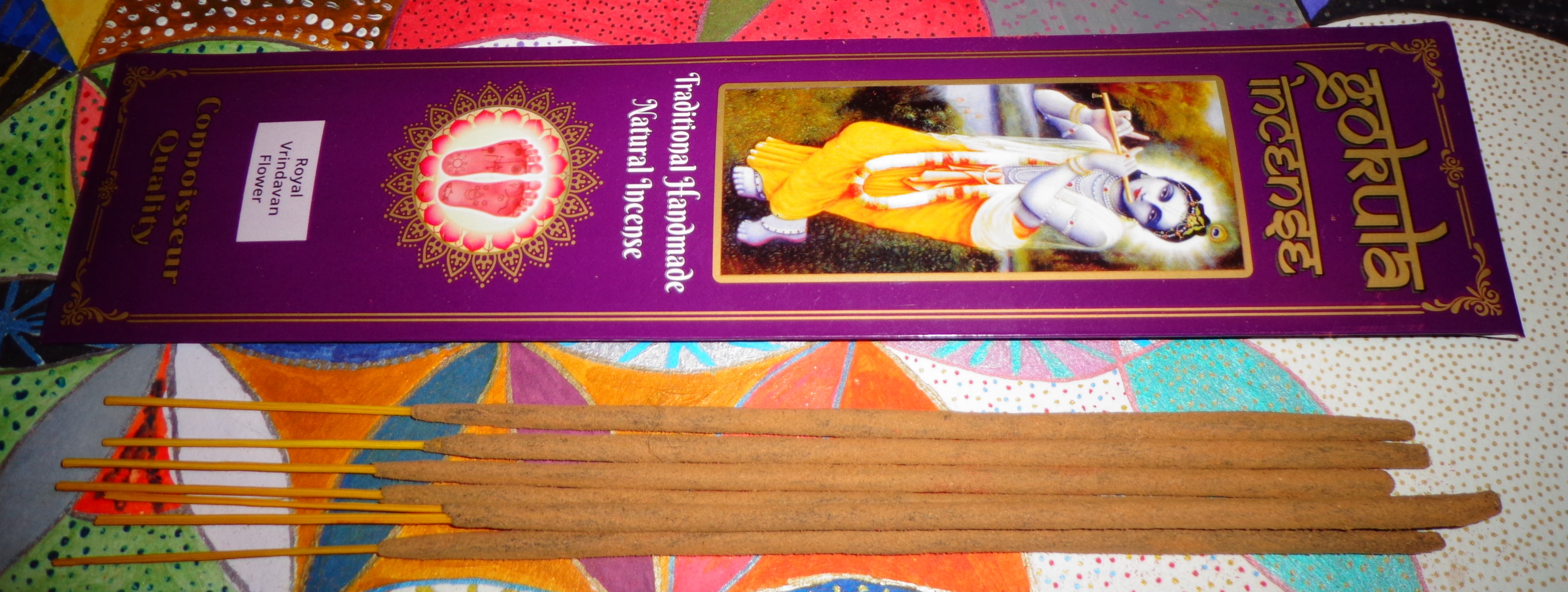 Every time I see an incense with Vrindavan in it, it’s kind of like musk or lotus, they’re so different from stick to stick that you can’t always be sure what you’re getting. But Gokula’s Royal Vrindavan Flower is a really gorgeous stick and mostly presents a champa-ish incense with a really beautiful and somewhat unique floral oil that I can’t remember every placing in an incense before, at least exactly. I’m not even sure how to describe it because it strikes me as being sort of pink, sort of lotus like, but ultimately really balanced. It’s a touch soft, so likely a bit of halmaddi is in the mix, but overall I love the pretty after effect of burning, it’s as if some of the perfume is separate from the smoke. Definitely one I’d put on your Gokula shopping list, this one’s quite special.
Every time I see an incense with Vrindavan in it, it’s kind of like musk or lotus, they’re so different from stick to stick that you can’t always be sure what you’re getting. But Gokula’s Royal Vrindavan Flower is a really gorgeous stick and mostly presents a champa-ish incense with a really beautiful and somewhat unique floral oil that I can’t remember every placing in an incense before, at least exactly. I’m not even sure how to describe it because it strikes me as being sort of pink, sort of lotus like, but ultimately really balanced. It’s a touch soft, so likely a bit of halmaddi is in the mix, but overall I love the pretty after effect of burning, it’s as if some of the perfume is separate from the smoke. Definitely one I’d put on your Gokula shopping list, this one’s quite special.
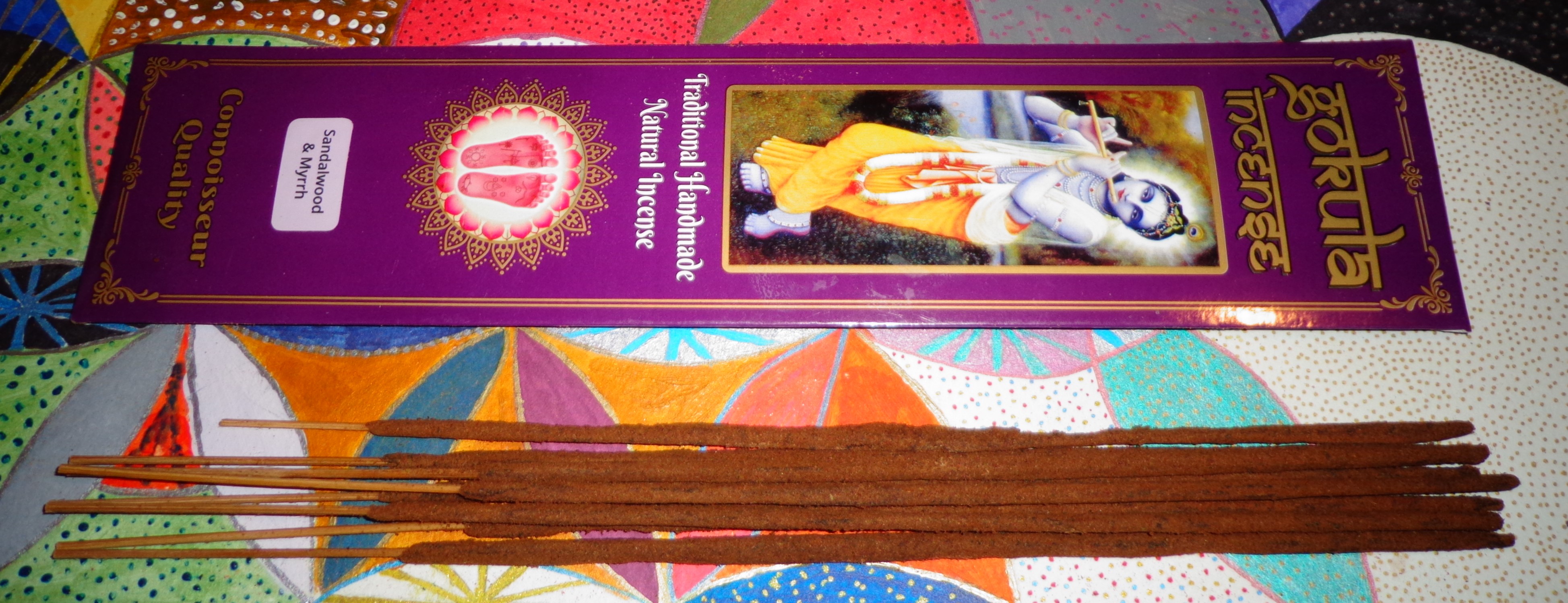 So I had almost forgot until I checked my notes but there was a slight snafu with my order (no worries the kind Gokula folks cleared it up right away) but I think there was one non-Madhavadas I did not get and then one Mahavadas I did get and that’s the Sandalwood & Myrrh. Madhavadas sourced incenses, of course, have their usual base (vanilla, sandalwood – often an equal aromatic note in any of their incenses) which, while the company tends to have a huge arsenal of top notes that are very good, can be quite fatiguing if used frequently. I’m not really quite sure if something like this would have been to my tastes whatever the source, but it does seem like a reasonable low grade sandalwood/myrrh mix, although the combination really evokes something different rather than the listed ingredients. The resin seems a bit more in front of the wood and certainly the base plays a part in it, but overall it feels a bit musky and a touch mysterious. I am pretty sure I have tried this before, may have been Pure Incense but it could have also been Primo, but ultimately it sort of gets on my nerves over the burn.
So I had almost forgot until I checked my notes but there was a slight snafu with my order (no worries the kind Gokula folks cleared it up right away) but I think there was one non-Madhavadas I did not get and then one Mahavadas I did get and that’s the Sandalwood & Myrrh. Madhavadas sourced incenses, of course, have their usual base (vanilla, sandalwood – often an equal aromatic note in any of their incenses) which, while the company tends to have a huge arsenal of top notes that are very good, can be quite fatiguing if used frequently. I’m not really quite sure if something like this would have been to my tastes whatever the source, but it does seem like a reasonable low grade sandalwood/myrrh mix, although the combination really evokes something different rather than the listed ingredients. The resin seems a bit more in front of the wood and certainly the base plays a part in it, but overall it feels a bit musky and a touch mysterious. I am pretty sure I have tried this before, may have been Pure Incense but it could have also been Primo, but ultimately it sort of gets on my nerves over the burn.
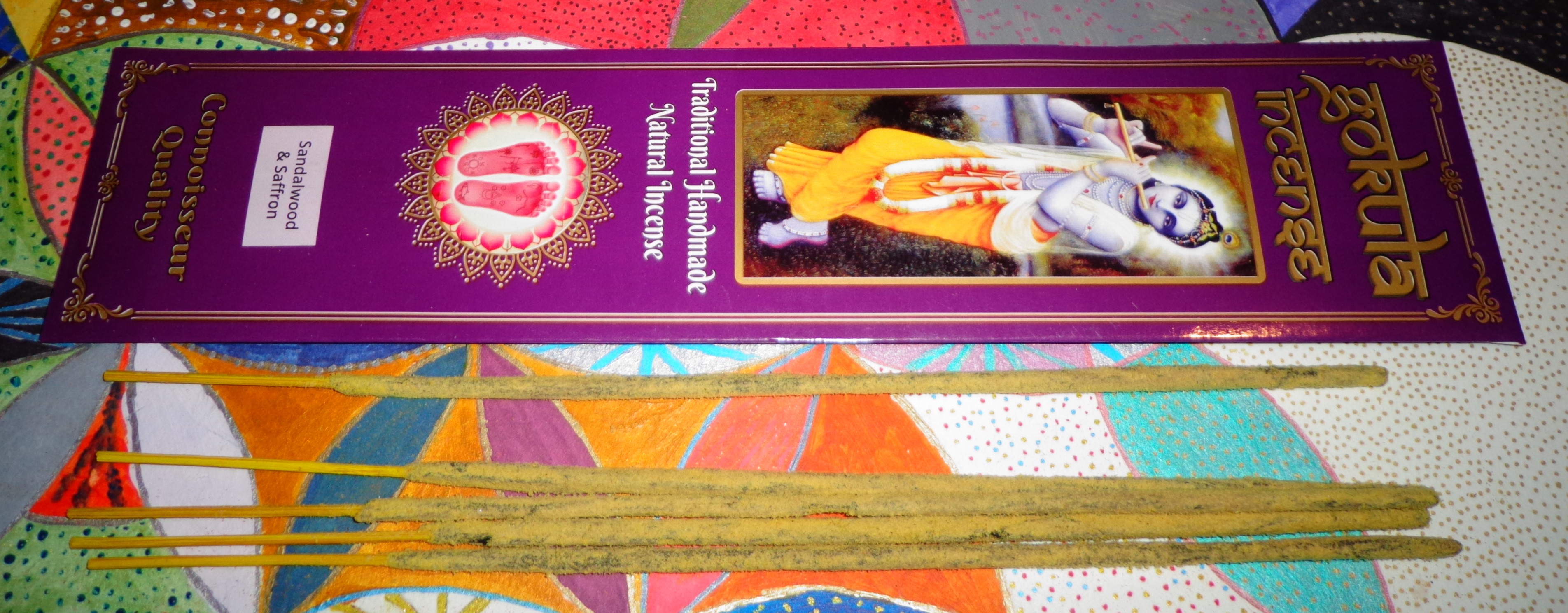 Visually, the Sandalwood & Saffron seems to look a lot like the yellow dusted thinner masalas we’ve seen so recently with the Absolute Bliss imported King of Saffron. This isn’t a really successful version of it, if it is, in fact it seems strangely a bit closer to a champa, except the combination of ingredients seems to leave the aroma sort of bitter and a bit incoherent. It’s almost like you can tell what they were going for but without distinct notes of either ingredient, it feels more like a sort of sour or bitter mix (perhaps a bit camphorous as well) with vanilla and other more sweeter accompaniment, and as a merger it doesn’t really work for me too well. I’m not sure if that’s because it doesn’t fit my expectations visually, but it just strikes me as a really odd mix. Saffron and sandalwood mixes really only work well if the resolution is higher and the qualities are kept to woody and dry.
Visually, the Sandalwood & Saffron seems to look a lot like the yellow dusted thinner masalas we’ve seen so recently with the Absolute Bliss imported King of Saffron. This isn’t a really successful version of it, if it is, in fact it seems strangely a bit closer to a champa, except the combination of ingredients seems to leave the aroma sort of bitter and a bit incoherent. It’s almost like you can tell what they were going for but without distinct notes of either ingredient, it feels more like a sort of sour or bitter mix (perhaps a bit camphorous as well) with vanilla and other more sweeter accompaniment, and as a merger it doesn’t really work for me too well. I’m not sure if that’s because it doesn’t fit my expectations visually, but it just strikes me as a really odd mix. Saffron and sandalwood mixes really only work well if the resolution is higher and the qualities are kept to woody and dry.
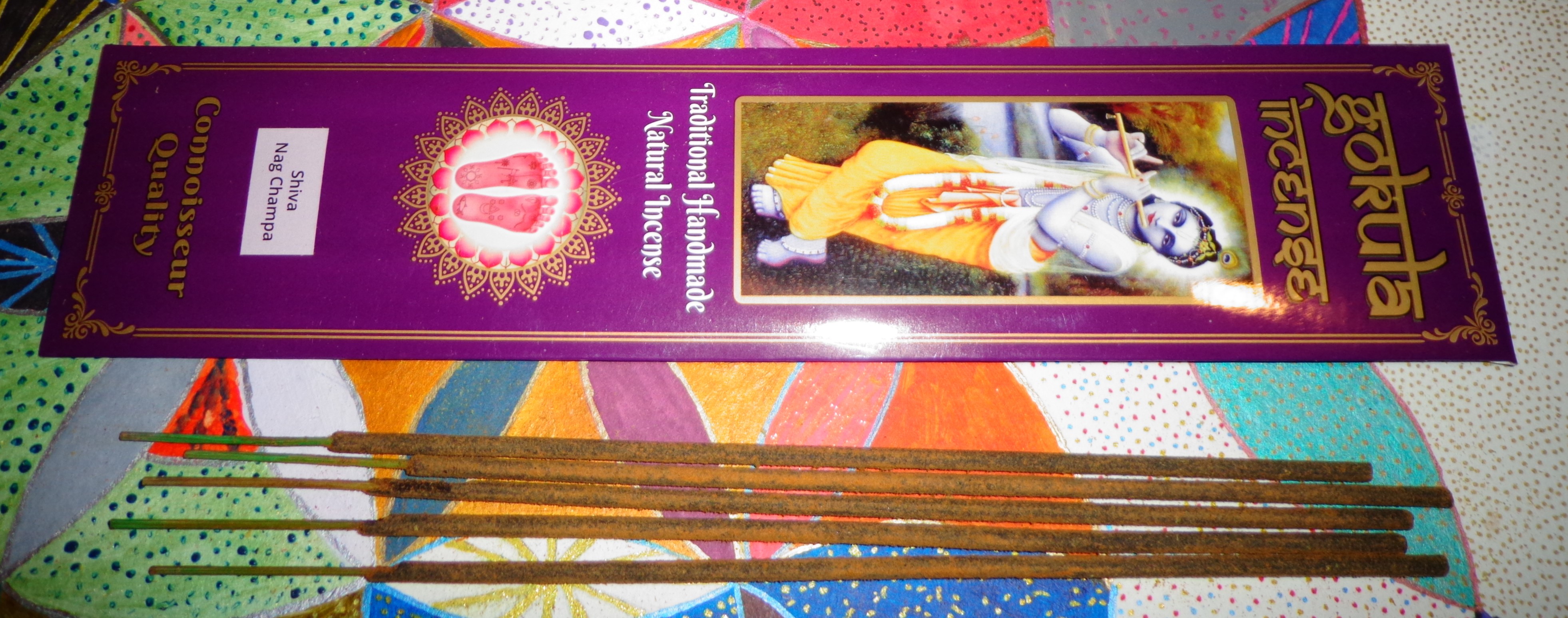 Although Shiva Nag Champa is not a Madhavadas incense, the top perfume does remind me of some of the Pure Incenses champas I’ve tried over the years. These perfumes aren’t all that reminiscent of say the Blue Box/Satya Nag Champa perfume or even the Gold Nagchampa/Vintage Nag Champa types you get from AB or Temple of Incense (it’s sort of like Nag Champa vs champa flower maybe?). This doesn’t have the powdery qualities of that scent and is instead much sweeter and piquant. It verges ever so slightly on bitter during the burn which seems to be aspects of the citrus in the mix as well, gulp, as a touch or urine or something. It’s a strangely complex and involved top note for what may seem like a critical perspective, but it could cause a bit of flip flop in impression because it’s like a mix of pleasant and notes that most are probably not going to like too much.
Although Shiva Nag Champa is not a Madhavadas incense, the top perfume does remind me of some of the Pure Incenses champas I’ve tried over the years. These perfumes aren’t all that reminiscent of say the Blue Box/Satya Nag Champa perfume or even the Gold Nagchampa/Vintage Nag Champa types you get from AB or Temple of Incense (it’s sort of like Nag Champa vs champa flower maybe?). This doesn’t have the powdery qualities of that scent and is instead much sweeter and piquant. It verges ever so slightly on bitter during the burn which seems to be aspects of the citrus in the mix as well, gulp, as a touch or urine or something. It’s a strangely complex and involved top note for what may seem like a critical perspective, but it could cause a bit of flip flop in impression because it’s like a mix of pleasant and notes that most are probably not going to like too much.
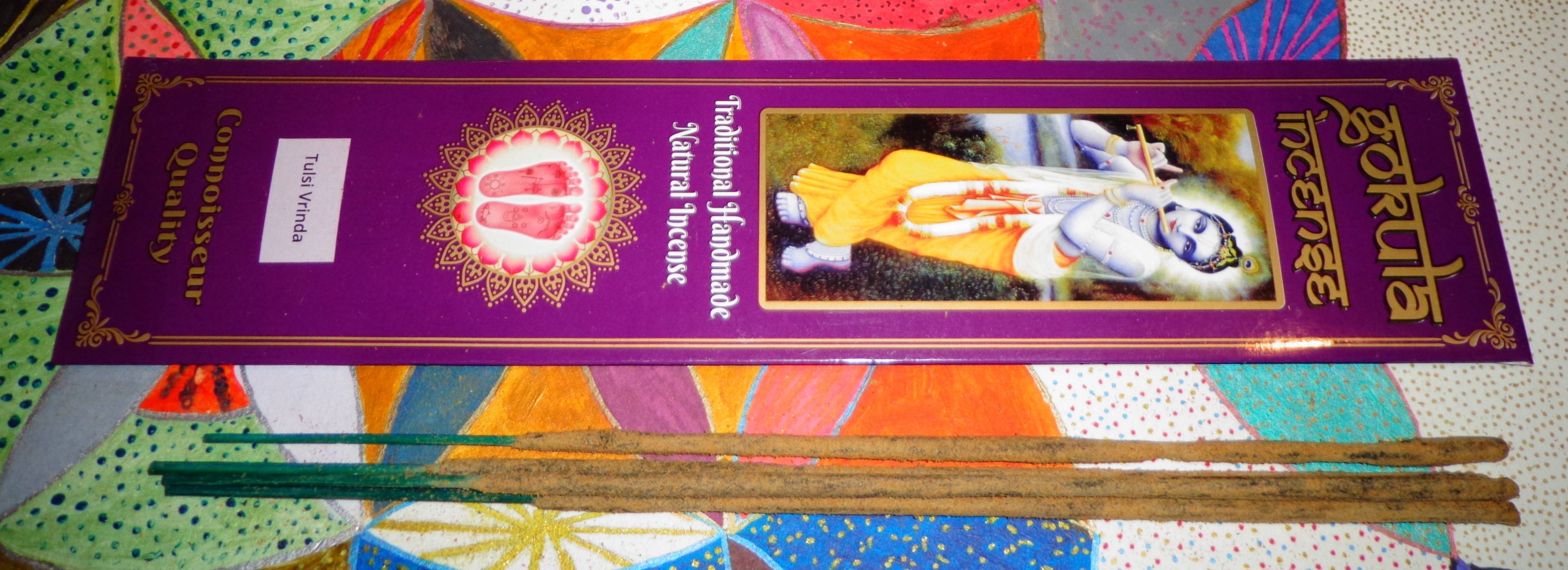 Tulsi Vrinda is an herbal incense that leans a bit in a spicier direction while still having a lot of the same powdery characteristics of Gokula florals. It’s cousin to something like the Kerala Flower in the Temple of Incense line or Happy Hari Samadhi Sutra. This isn’t Tulsi (basil) in the same way the Temple of Incense stick is, but it has some hints of that scent buried in an overall base. It’s enough to perhaps give this incense a bit of personality that some of the others don’t have. There’s also a bit of woodiness in the mix that prevents it from getting too pink or sweet.
Tulsi Vrinda is an herbal incense that leans a bit in a spicier direction while still having a lot of the same powdery characteristics of Gokula florals. It’s cousin to something like the Kerala Flower in the Temple of Incense line or Happy Hari Samadhi Sutra. This isn’t Tulsi (basil) in the same way the Temple of Incense stick is, but it has some hints of that scent buried in an overall base. It’s enough to perhaps give this incense a bit of personality that some of the others don’t have. There’s also a bit of woodiness in the mix that prevents it from getting too pink or sweet.
So this installment wraps up the Gokula reviews! As you can see there are some definite highlights in the last four reviews, for sure the Musk & Amber and Royal Vrindavan Flower are really strong, and just coming behind those I’d recommend the Jasmine & Nag Champa, Lotus & Kewra, Musk Heena and Rose & Saffron (so all six would make a good starter order). A lot of other scents could be growers in hindsight as well, with a number of solid scents in the middle, but for the most part this is a decent quality line overall and at least this “half” of the line has a profile that might be different than what you’d tried before.
You must be logged in to post a comment.